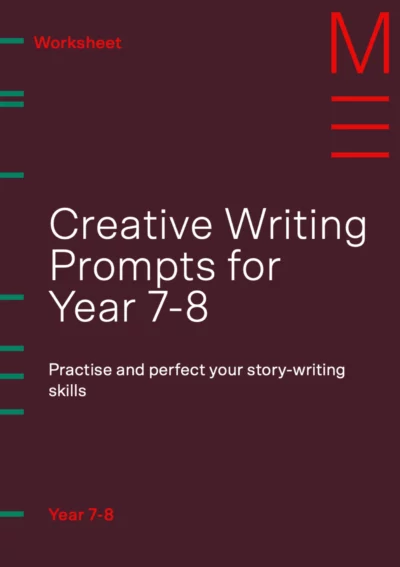Welcome to Matrix Education
To ensure we are showing you the most relevant content, please select your location below.
Select a year to see courses
Learn online or on-campus during the term or school holidays
Learn online or on-campus during the term or school holidays
Learn online or on-campus during the term or school holidays
Learn online or on-campus during the term or school holidays
Learn online or on-campus during the term or school holidays
Learn online or on-campus during the term or school holidays
Learn online or on-campus during the term or school holidays
Learn online or on-campus during the term or school holidays
Learn online or on-campus during the term or school holidays
Learn online or on-campus during the term or school holidays
Select a year to see available courses
Science guides to help you get ahead
Science guides to help you get ahead
Wondering what to write about in creative writing? These 10 fun creative writing prompts will help you build your writing skills and spark creativity—perfect for Year 7 and 8 students in English!

Join 75,893 students who already have a head start.
"*" indicates required fields
Related courses

Join 8000+ students each term who already have a head start on their school academic journey.
Creative writing is one of the most powerful ways to use your imagination. It can be used both expressively and productively.
In this article, you’ll learn how to build better stories and use creative prompts based on the Australian Curriculum. These prompts are perfect for students in Year 7 and Year 8 English.
Let’s get writing!
Even if you haven’t read the suggested texts, you can still find value in these prompts!
The setting is where your story takes place. The mood is the feeling your story gives the reader, like scary, peaceful, or exciting.
A strong setting makes your story feel real. Mood helps your reader feel what the characters feel.
Use the five senses (sight, sound, touch, smell, and taste) to build mood. Think about how the setting changes as the story goes on. This will add tension or calm, depending on what you want your reader to feel.
So now, practise making descriptions of different settings. This will help you become better at telling and showing, so you can make places feel real and bring out emotions in your stories.
Sample prompt:
HSC writing strategies from expert English teachers
Band 6 resources to get you exam-ready. Join the 96% of our students that have improved their marks.
Who tells your story matters. If you change the narrator, the whole story can feel different. This is called writing from a new point of view. It helps you explore other characters’ thoughts, feelings, and experiences.
By shifting perspectives, you can learn more about why characters act the way they do.
It also affects how the reader sees the events in the story, sometimes making them more emotional, surprising, or even confusing, depending on the perspective used.
Practise taking a narrative text and then changing the narrator; rewrite it from a different character’s point of view. You can change the narrator of your story to another character in the story or perhaps a new character.
Sample prompt:
| They have never known pain, he thought. The realization made him feel desperately lonely, and he rubbed his throbbing leg. He eventually slept. Again and again he dreamed of the anguish and the isolation on the forsaken hill. The daily training continued, and now it always included pain. The agony of the fractured leg began to seem no more than a mild discomfort as The Giver led Jonas firmly, little by little, into the deep and terrible suffering of the past. Each time, in his kindness, The Giver ended the afternoon with a color-filled memory of pleasure: a brisk sail on a blue-green lake; a meadow dotted with yellow wildflowers; an orange sunset behind mountains. It was not enough to assuage the pain that Jonas was beginning, now, to know. “Why?” Jonas asked him after he had received a torturous memory in which he had been neglected and unfed; the hunger had caused excruciating spasms in his empty, distended stomach. He lay on the bed, aching. “Why do you and I have to hold these memories?” “It gives us wisdom,” The Giver replied. “Without wisdom I could not fulfill my function of advising the Committee of Elders when they call upon me.” |
Most stories follow a beginning-middle-end pattern. But some stories are told out of order, using flashbacks or jumps in time. This is called a non-linear structure.
Changing the order of events can build suspense or reveal surprises in interesting ways.
Practise restructuring a narrative and see how these changes affect the reader.
This helps build suspense and makes readers curious about what will happen next.
Sample prompt:
A symbol is something that stands for a bigger idea, like a storm representing anger. Imagery is detailed descriptions to help readers imagine what’s happening.
Experiment using different symbolism to add deeper meanings to your story. Use different imagery to help the reader feel what the narrator feels. Together, these tools make your writing more powerful and get a stronger emotional response from your readers.
Sample prompt:
Start with a big idea and build your story around it.
A theme is the big idea behind a story, like friendship, change, or identity. Starting with a theme helps you plan your characters, setting, and plot so they all connect to the same message.
Themes make your stories deeper and more relatable.
Sample prompt:
Context means the time and place your story is set in. It shapes what your characters believe, how they act, and the problems they face. Thinking about context helps make your story more realistic and meaningful.
You can choose a real historical event or imagine life in a different culture or time.
By setting your story in a specific context, you can create more complex characters whose actions reflect their world.
Sample prompt:
| 25th June 1166, 10.40 pm I don’t want to eat. Stew, potatoes and biscuits. I usually like stew, but I’ve no appetite for it. I nibble at the biscuit, but I don’t want that either. Not now. It’s a good thing Grandma Wolf is not here. She always hated us leaving food on our plates. “Waste not, want not,” she’d say. I’m wasting this, Wolfwoman, whether you like it or not. |
Help boost your child's skills in English and Maths
Expert teachers and high-quality resources trusted by 8,000+ families each term. Book a free trial lesson.
Genre is the type of story you’re writing, like romance, fantasy, mystery, or horror. Different genres use different styles, structures, and techniques to create different effects.
Try transforming your favourite stories into new genres, such as turning a mystery into a romance or a fantasy into a thriller.
For example, you could rewrite Harry Potter as a detective story, where Harry investigates mysterious happenings at Hogwarts instead of battling Voldemort. This exercise allows you to explore how genre influences storytelling and shapes a reader’s experience.
Sample prompt:
Your writing voice is the way you express yourself on the page. It reflects your personality and how you see the world. When you write with your own voice, your story feels honest and engaging.
Try writing something personal, something only you could write.
Sample prompt:
“So I draw because I want to talk to the world. And I want the world to pay attention to me. I feel important with a pen in my hand. I feel like I might grow up to be somebody important. An artist. Maybe a famous artist. Maybe a rich artist”
Every piece of writing has a goal. It might entertain, inform, persuade, or analyse something.
Knowing your goal helps you choose the best words and structure for your writing.
Practise writing different texts with different purposes.
Sample prompt:
Rewriting a famous story helps you practise creativity while working with a well-known plot. You can change the point of view, setting, or time period to create something new and fresh.
It’s a great way to explore new ideas and show your creativity.
Sample prompt:
Mercutio, Romeo’s witty and loyal friend, often hides his true feelings behind jokes.
Rewrite a scene from Romeo and Juliet from Mercutio’s perspective. What emotions or secrets might he be hiding? Use a poetic style, but make it your own.
These prompts help you practise creative writing skills and build your storytelling. Don’t worry if your first draft isn’t perfect. Just start writing and enjoy the process.
Get inspired with free creative writing prompts for Year 7-8 English Fill out your details below to get this resource emailed to you. "*" indicates required fields
Practise with these creative writing prompts!

Practise with these creative writing prompts!
Written by Matrix English Team
The Matrix English Team are tutors and teachers with a passion for English and writing, and a dedication to seeing Matrix Students achieving their academic goals.© Matrix Education and www.matrix.edu.au, 2025. Unauthorised use and/or duplication of this material without express and written permission from this site’s author and/or owner is strictly prohibited. Excerpts and links may be used, provided that full and clear credit is given to Matrix Education and www.matrix.edu.au with appropriate and specific direction to the original content.